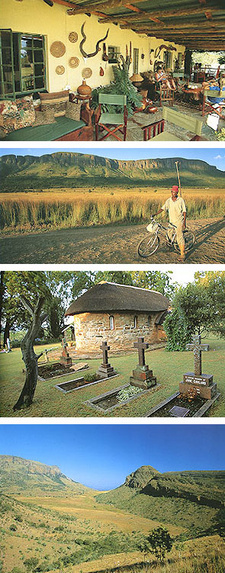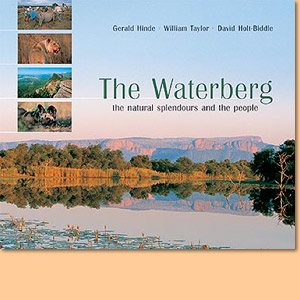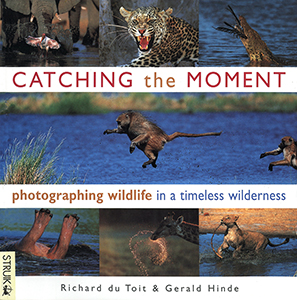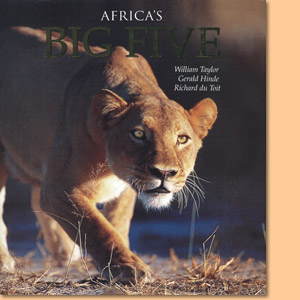The Waterberg. The Natural Splendours and the People, by Gerald Hinde, David Holt-Biddle and William Taylor

The Waterberg. The Natural Splendours and the People, by Gerald Hinde, David Holt-Biddle and William Taylor.
Foreword to The Waterberg: The Natural Splendours and the People, is written by Gerald Hinde.
Gerald Hinde William Taylor David Holt-Biddle
The Waterberg has a natural beauty which, for those who know the area well, is unmatched elsewhere - from its soaring craggy heights on the southern escarpment where the 'Seven Sisters' guard the plains, to the north-eastern buttresses of spectacular rock formations, rising sheer out of the bushveld lowlands. It also gives one a sense of limitless space: the central plateau provides an extraordinary feeling of emptiness, despite the fact that early man has lived here for thousands of years, as evidenced by the abundance of rock art and ancient archaeological sites. Straddling an area of 15000 sqkm in Limpopo, the Waterberg region has gone almost unnoticed for decades. With its brooding mountain ranges it conjures up images of gun runners, tax evaders, remittance men and hunters; but the real people who have settled here are serious-minded pioneer folk and their families, who have put down deep roots within these hills and valleys. Its extraordinary biodiversity, geological features and cultural aspects make this area a special place to visit and live in. The Waterberg was so named by the early trekkers for its bounteous supply of clear water. Eugene Marais, acclaimed author and father of African ethology, observed that the passage of wagons was impeded by the enormous amount of water found in the region. The name is apt for, in times of good rain, there is continuous seepage and flow of water from within these mountain ranges. In spite of its name, the Waterberg region is also known to experience extreme droughts. This and the fact that it is largely a sourveld area mean that farming can be difficult. During the past decade there have been great changes in land use practices, which have seen the switch from conventional farming to the introduction of wildlife and the adoption of conservation principles.
The challenge ahead rests with those who are custodians of this recently proclaimed UNECSO Waterberg Biosphere Reserve, which is the first savanna biosphere reserve registered in southern Africa. Their mission will be to restore the wildlife, protect its biodiversity, provide business and work opportunities, as well as upliftment, learning and tourism - in general, their mission will be to care for what is a key conservation area in South Africa. The photographer and authors of this book have combined their considerable talents to produce a work that does justice to this place of immense beauty. They could not have achieved this if they themselves had not been captivated, as we all have been, by the mysterious deep blue of the Waterberg spirit. I am sure this book will help unlock the secrets to the 'soul' of the Waterberg.
Content:
Foreword
Acknowledgements
Introduction
1. Waterberg in the making
2. People of the Waterberg
3. A son of the Waterberg
4. Flora and Fauna
Conservation and upliftment
Appendix: Visitors' information
References
Index
This is an extract from the book: The Waterberg. The Natural Splendours and the People, by Gerald Hinde, David Holt-Biddle and William Taylor.
Book title: The Waterberg
Subtitle: The Natural Splendours and the People
Authors: Gerald Hinde; David Holt-Biddle; William Taylor
Struik Publishers
Cape Town, South Africa 2003
ISBN-10: 1868728226
ISBN-13: 9781868728220
Softcover, dustjacket, 29x24 cm, 176 pages, throughout colour photos
Hinde, Gerald und Taylor, William und Holt-Biddle, David im Namibiana-Buchangebot
The Waterberg. The Natural Splendours and the People
This wonderful illustraded book unlocks the secrets to the soul of the Waterberg in South Africa.
Catching the Moment: Photographing Wildlife In a Timeless Wilderness
In Catching the Moment: Photographing Wildlife In a Timeless Wilderness, the photographers share a wealth of advice and useful information on how they captured the images in Botswana.
Africa's Big Five
The authors of Africa's Big Five present experiences and insights they have gained through years of close observation.



